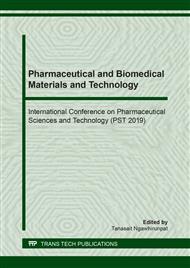[1]
T. Srichan, T. Phaechamud. Designing solvent exchange-induced in situ forming gel from aqueous insoluble polymers as matrix base for periodontitis treatment. AAPS J. 18(2017), 194-201.
DOI: 10.1208/s12249-016-0507-1
Google Scholar
[2]
P. Domínguez de María, E. Fernández-Álvaro, A. ten Kate, G. Bargeman. Role of apparent pKa of carboxylic acids in lipase-catalyzed esterifications in biphasic systems. J Mol Catal B: Enzym. 59(2009), 220-224.
DOI: 10.1016/j.molcatb.2009.03.004
Google Scholar
[3]
T. Eryilmaz, M. K. Yesilyurt. Influence of blending ratio on the physicochemical properties of safflower oil methyl ester-safflower oil, safflower oil methyl ester-diesel and safflower oil-diesel. Renew Energy. 95(2016), 233-247.
DOI: 10.1016/j.renene.2016.04.009
Google Scholar
[4]
T. Phaechamud, S. M. Thurein, T. Chantadee. Role of clove oil in solvent exchange-induced doxycycline hyclate-loaded Eudragit RS in situ forming gel. Asian J Pharm. 13(2018), 131-142.
DOI: 10.1016/j.ajps.2017.09.004
Google Scholar
[5]
T. Phaechamud, O. Setthajindalert. Cholesterol in situ forming gel loaded with doxycycline hyclate for intra-periodontal pocket delivery. Eur J Pharm Sci. 99(2017), 258-265.
DOI: 10.1016/j.ejps.2016.12.023
Google Scholar
[6]
F. Boudy, P. Seers. Impact of physical properties of biodiesel on the injection process in a common-rail direct injection system. Energy Convers Manage. 50(2009), 2905-2912.
DOI: 10.1016/j.enconman.2009.07.005
Google Scholar
[7]
C. M. Rodenbush, F. H. Hsieh, D. S. Viswanath. Density and viscosity of vegetable oils. J Am Oil Chem Soc. 76(1999), 1415-1419.
DOI: 10.1007/s11746-999-0177-1
Google Scholar
[8]
A. Obeidat, A. Jaradat, B. Hamdan, H. Abu-Ghazleh. Effect of cutoff radius, long range interaction and temperature controller on thermodynamic properties of fluids: Methanol as an example. Physica A. 496(2018), 243-248.
DOI: 10.1016/j.physa.2018.01.001
Google Scholar
[9]
S. Kahwaji, M. B. Johnson, A. C. Kheirabadi, D. Groulx, M. A. White. Fatty acids and related phase change materials for reliable thermal energy storage at moderate temperatures. Sol Energy Mater Sol Cells. 167(2017), 109-120.
DOI: 10.1016/j.solmat.2017.03.038
Google Scholar
[10]
M. A. Eiteman, J. W. Goodrum. Density and viscosity of low-molecular weight triglycerides and their mixtures. J Am Oil Chem Soc. 71(1994), 1261.
DOI: 10.1007/bf02540548
Google Scholar
[11]
K. H. D. a. K. V. W. Vijay D. Wagh. Formulation and evaluation of in situ gel drug delivery system of sesbania grandiflora flower extract for the treatment of bacterial conjunctivitis. J Pharm Sci Res. 4(2012), 1880-1884.
Google Scholar
[12]
D. M. Small. 1986. The physical chemistry of lipids : from Alkanes to phospholipids. Handbook of lipid research. 4. Plenum Press. New York. p.264.
Google Scholar
[13]
S. Meng, Y. Ma, D.-W. Sun, L. Wang, T. Liu. Properties of starch-palmitic acid complexes prepared by high pressure homogenization. J Cereal Sci. 59(2014), 25-32.
DOI: 10.1016/j.jcs.2013.10.012
Google Scholar
[14]
M. Parent, C. Nouvel, M. Koerber, A. Sapin, P. Maincent, A. Boudier. PLGA in situ implants formed by phase inversion: Critical physicochemical parameters to modulate drug release. J Control Release. 172(2013), 292-304.
DOI: 10.1016/j.jconrel.2013.08.024
Google Scholar
[15]
V. F. Patel, N. M. Patel. Statistical evaluation of influence of viscosity and content of polymer on dipyridamole release from floating matrix tablets: A technical note. AAPS PharmSciTech. 8(2007), E140-E144.
DOI: 10.1208/pt0803069
Google Scholar
[16]
E. Agostini, G. Winter, J. Engert. Water-based preparation of spider silk films as drug delivery matrices. J Control Release. 213(2015), 134-141.
DOI: 10.1016/j.jconrel.2015.06.025
Google Scholar
[17]
F. M. Fowkes. 1983. Acid–base interactions in polymer adhesion. In: Kittal K. L., editor. Physicochemical Aspects of Polymer Surfaces. 2. Plenum Press. pp.583-603.
Google Scholar
[18]
J. A. Camargo, A. Sapin, C. Nouvel, D. Daloz, M. Leonard, F. Bonneaux, et al. Injectable PLA-based in situ forming implants for controlled release of Ivermectin a BCS Class II drug: solvent selection based on physico-chemical characterization. Drug Dev Ind Pharm. 39(2013), 146-155.
DOI: 10.3109/03639045.2012.660952
Google Scholar
[19]
S. Gokulanathan, N. Balan, R. Aravind, K. Thangavelu. Patient compliance and supportive periodontal therapy: Study among young adults of Namakkal district. J Pharm Bioallied Sci. 6(2014), 171-173.
DOI: 10.4103/0975-7406.137443
Google Scholar
[20]
C. B. Huang, Y. Alimova, T. M. Myers, J. L. Ebersole. Short- and medium-chain fatty acids exhibit antimicrobial activity for oral microorganisms. Arch Oral Biol. 56(2011), 650-654.
DOI: 10.1016/j.archoralbio.2011.01.011
Google Scholar


